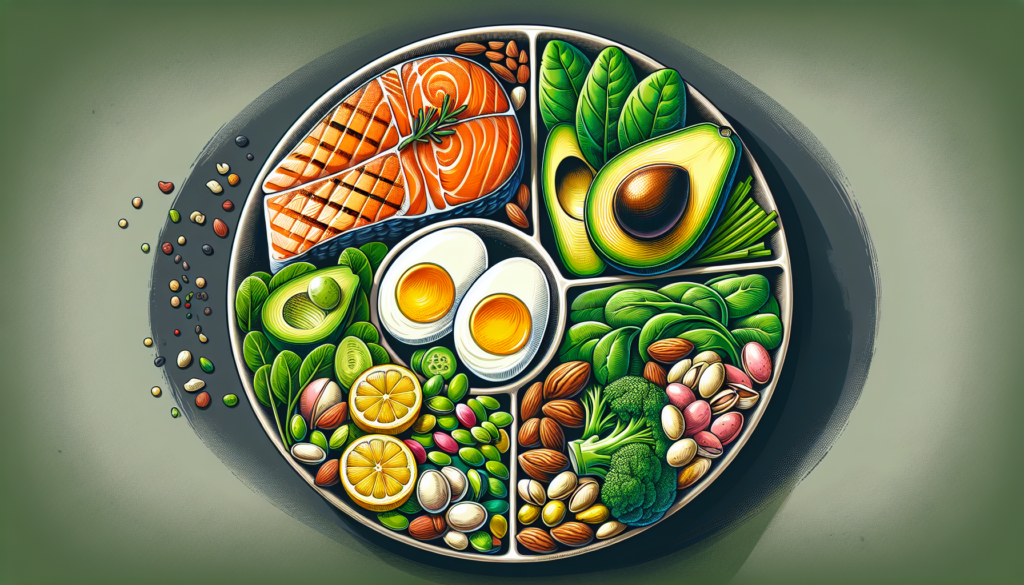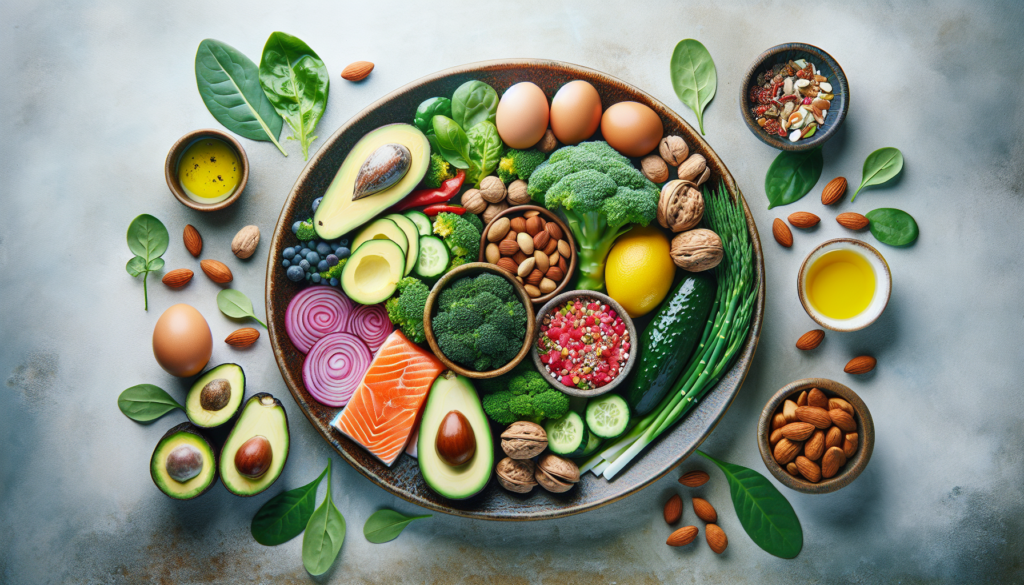Are you looking to kickstart your health and fitness journey? Look no further than “The Ultimate Guide to the Keto Diet.” This comprehensive guide will provide you with all the information you need to master the ketogenic diet and achieve your desired goals. From understanding the science behind ketosis to creating delicious and satisfying meals, this guide has got you covered every step of the way. Say goodbye to restrictive diets and hello to a lifestyle that promotes weight loss, mental clarity, and increased energy levels. Get ready to embark on a transformative journey that will change the way you think about food and nourish your body from the inside out.

What is the Keto Diet?
Definition of the Keto Diet
The Keto Diet, short for Ketogenic Diet, is a low-carbohydrate, high-fat diet that has gained popularity in recent years. The goal of this diet is to shift your body into a state of ketosis, where it primarily burns fat for energy instead of carbohydrates.
How Does the Keto Diet Work?
The Keto Diet works by drastically reducing your intake of carbohydrates and increasing your consumption of fats. Typically, when you eat carbohydrates, your body converts them into glucose, which is then used as the main source of energy. However, when your carbohydrate intake is limited, your body begins to utilize stored fat as its primary fuel source. This metabolic shift leads to the production of ketones, which are molecules that serve as an alternative energy source.
Benefits of the Keto Diet
The Keto Diet has gained traction for its potential health benefits. Here are some of the main advantages associated with following a ketogenic eating plan:
-
Weight Loss: By restricting carbohydrates and increasing fat intake, the Keto Diet promotes weight loss. This occurs due to the body’s increased reliance on stored fats for energy.
-
Improved Blood Sugar Control: The Keto Diet may help stabilize blood sugar levels and improve insulin sensitivity, making it beneficial for individuals with type 2 diabetes or those at risk of developing the condition.
-
Increased Energy Levels: Many individuals report increased energy and mental clarity when following the Keto Diet. This is due to the steady supply of fuel from fats and the absence of blood sugar spikes and crashes.
-
Reduced Inflammation: Some research suggests that the Keto Diet may help reduce inflammation, which is linked to various chronic diseases, such as heart disease and certain types of cancer.
-
Enhanced Brain Function: The Keto Diet has been studied for its potential cognitive benefits, including improved focus, mental clarity, and protection against neurodegenerative diseases.
Getting Started with the Keto Diet
Consulting a Healthcare Professional
Before embarking on any dietary change, it is important to consult with a healthcare professional. They can assess whether the Keto Diet is suitable for your individual needs and health conditions. They may also provide guidance on how to make the transition safely and effectively.
Understanding Macros
When following the Keto Diet, it is crucial to understand the concept of macronutrients, often referred to as “macros.” These include carbohydrates, fats, and proteins. On the Keto Diet, the macronutrient distribution is typically 70-75% of calories from fat, 20-25% from protein, and 5-10% from carbohydrates.
Determining Daily Caloric Intake
To achieve your desired health goals on the Keto Diet, you need to establish and monitor your daily caloric intake. Using online calculators or working with a nutritionist can help determine the ideal calorie range for you based on factors such as age, gender, weight, height, and activity level.
Preparing Your Kitchen
One of the keys to success on the Keto Diet is to have a well-stocked kitchen filled with keto-friendly food options. Remove any tempting high-carbohydrate foods from your pantry and replace them with healthy fats, low-carb vegetables, and other keto-approved ingredients. This will make it easier to stick to the diet and avoid potential setbacks.
Meal Planning and Grocery Shopping
Meal planning is essential when following the Keto Diet, as it helps ensure a balanced and nutritious intake of macros. Plan your meals ahead of time, including breakfast, lunch, dinner, and snacks, and create a grocery shopping list based on these meal plans. Shopping with a list can help you stay on track and avoid purchasing non-keto items.
Tracking Your Progress
Keeping track of your progress is crucial for staying motivated and making adjustments when necessary. Consider tracking your food intake, weight, measurements, and any other relevant health markers. This can be done using a journal, mobile apps, or online platforms specifically designed for tracking on the Keto Diet.
Keto-Friendly Foods
Healthy Fats
A cornerstone of the Keto Diet is consuming healthy fats, which provide energy and satiety. Some excellent sources of healthy fats include avocados, olive oil, coconut oil, grass-fed butter, fatty fish (such as salmon and sardines), and nuts and seeds (like almonds and chia seeds).
Protein Sources
Although the emphasis of the Keto Diet is on fats, it is essential to include an adequate amount of protein in your meals. Good protein sources for the Keto Diet include chicken, turkey, beef, pork, eggs, and seafood. Opt for grass-fed or organic options whenever possible.
Low-Carb Vegetables
Low-carbohydrate vegetables are an excellent addition to the Keto Diet, as they provide essential vitamins, minerals, and fiber without contributing significantly to carbohydrate intake. Some examples of keto-friendly vegetables include leafy greens (spinach, kale), broccoli, cauliflower, zucchini, bell peppers, and Brussels sprouts.
Dairy Products
Dairy products can be a part of the Keto Diet, but it is important to choose options that are low in carbohydrates. Full-fat dairy products like cheese, butter, and heavy cream are typically acceptable on the Keto Diet. However, it’s essential to monitor your intake and choose products that fit within your daily carbohydrate allowance.
Nuts and Seeds
Nuts and seeds are convenient and nutritious snacks that can be included in a well-rounded keto diet. Almonds, walnuts, flax seeds, chia seeds, and pumpkin seeds are among the options that provide healthy fats and protein. However, be mindful of portion sizes, as they are calorie-dense.
Beverages
While water is the best beverage choice on the Keto Diet, it’s common to crave variety. Opt for unsweetened tea, black coffee, and sparkling water for calorie-free options. If you prefer something more flavorful, you can incorporate keto-friendly options like unsweetened almond or coconut milk, or sugar-free flavored beverages.
Sweeteners
Traditional sweeteners are high in carbohydrates and thus not compatible with the Keto Diet. However, there are keto-friendly sweeteners available, such as stevia, erythritol, or monk fruit sweetener. These alternatives can satisfy your sweet tooth without raising your blood sugar levels.
Seasonings and Condiments
When it comes to seasonings and condiments, be mindful of hidden carbohydrates and additives. Opt for natural herbs, spices, and condiments that are low in carbohydrates and free from additives and added sugars.
Foods to Avoid on the Keto Diet
Sugary Foods and Drinks
An essential aspect of the Keto Diet is avoiding sugar in all its forms. This includes not only obvious sources like candy, soda, and baked goods but also hidden sugars found in sauces, dressings, and processed foods. Be vigilant about checking labels for sugar content.
Grains and Starches
Grains and starches are typically high in carbohydrates and should be avoided on the Keto Diet. This means saying goodbye to bread, rice, pasta, and other grain-based products. Instead, focus on the abundance of low-carb vegetable alternatives available.
Fruit (in Moderation)
While fruit is generally a healthy food choice, it can be high in natural sugars, making it a limited part of the Keto Diet. Enjoy small portions of low-sugar fruits like berries, while avoiding high-sugar options like bananas or mangoes.
High-Carb Vegetables
Certain vegetables, although nutritious, are relatively high in carbohydrates and should be consumed in moderation on the Keto Diet. These include starchy vegetables like potatoes, corn, and sweet potatoes. Instead, prioritize non-starchy vegetables with a lower carbohydrate content.
Processed Foods and Junk Food
Processed foods and junk food are generally off-limits on the Keto Diet due to their high carbohydrate and unhealthy fat content. These items are often packed with hidden sugars, additives, and unhealthy oils, which can hinder ketosis and negatively impact overall health.
Alcohol
Alcohol consumption can hinder progress on the Keto Diet due to its high sugar and carbohydrate content. Additionally, alcohol is metabolized differently in the body, potentially interrupting ketosis. If you choose to drink alcohol, opt for dry wines or spirits with minimal mixers and always consume in moderation.

Meal Ideas for the Keto Diet
Breakfast Options
- Scrambled eggs cooked in butter with avocado and smoked salmon
- Coconut milk chia pudding topped with berries and almonds
- A spinach and mushroom omelet served with bacon
Lunch and Dinner Ideas
- Grilled chicken breast with roasted Brussels sprouts and cauliflower mash
- Pan-seared salmon with steamed broccoli and a side of mixed greens
- Beef stir-fry with peppers, onions, and zucchini noodles
Snack Ideas
- Hard-boiled eggs
- Celery sticks with almond butter
- Cheese slices or cheese crisps
- Beef or turkey jerky
- Cucumber slices with guacamole
Dessert Options
- Keto-friendly cheesecake made with almond flour crust and sugar-free sweeteners
- Dark chocolate dipped in almond butter
- Mixed berries topped with whipped cream (sweetened with a keto-friendly sweetener)
- Homemade keto fat bombs (made with coconut oil, nuts, and natural sweeteners)
Tips for Success on the Keto Diet
Stay Hydrated
Proper hydration is essential when following the Keto Diet. Aim to drink at least 8 cups (64 ounces) of water per day and more if you are physically active or in a hot climate. Staying hydrated is necessary for overall health, as well as maintaining optimal bodily functions.
Manage Electrolytes
Transitioning to a low-carb diet can cause changes in electrolyte balance. To prevent symptoms like fatigue, muscle cramps, or headaches, ensure you consume adequate amounts of electrolytes like sodium, potassium, and magnesium. Adding a pinch of sea salt to meals or drinking electrolyte-containing beverages can be helpful.
Practice Portion Control
While the Keto Diet emphasizes high-fat foods, portion control is still crucial. Overeating any macronutrient, including fats, can hinder weight loss or lead to weight gain. Be mindful of portion sizes and listen to your body’s hunger and fullness cues.
Stick to Whole Foods
Choosing whole and unprocessed foods is essential on the Keto Diet. These foods are typically higher in nutrients and lower in unhealthy additives. Opt for fresh meats, fish, vegetables, and healthy fats rather than relying on packaged or processed alternatives.
Be Patient with Your Body
Every individual’s journey on the Keto Diet is unique, and adjustment periods can vary. Weight loss, increased energy levels, and other benefits may take time to occur. Be patient with your body and trust the process while making adjustments as needed.
Seek Support and Accountability
Embarking on a new dietary lifestyle can be challenging, so seeking support and accountability can make a significant difference. Join online forums, connect with friends or family members who are also following the Keto Diet, or consider partnering with a buddy who can provide motivation and encouragement.
Common Challenges and Solutions on the Keto Diet
Keto Flu
Some individuals may experience flu-like symptoms, known as the “keto flu,” when transitioning to the Keto Diet. This can include fatigue, headaches, irritability, and dizziness. To alleviate these symptoms, it is vital to stay hydrated, consume adequate electrolytes, and give your body time to adjust.
Cravings for Carbohydrates
Carbohydrate cravings can be challenging while following the Keto Diet, especially during the initial stages. To combat these cravings, focus on consuming satisfying meals rich in healthy fats and proteins. Additionally, finding keto-friendly alternatives to your favorite high-carb foods can help alleviate the desire to “cheat.”
Social Events and Dining Out
Navigating social events or dining out while on the Keto Diet can be challenging. Planning ahead by checking menus, choosing keto-friendly restaurants, or bringing your own keto-approved dish can help you stay on track. Additionally, good communication with friends, family, and hosts about your dietary needs can make the experience more manageable.
Plateaus in Weight Loss
Weight loss plateaus can occur on any diet, including the Keto Diet. If you find yourself at a weight loss stall, consider reviewing your macronutrient intake, reassessing portion sizes, or incorporating intermittent fasting to stimulate fat burning. Patience, perseverance, and experimentation are key during these periods.
Traveling on the Keto Diet
Traveling can present unique challenges on the Keto Diet. To maintain your dietary goals while away from home, research keto-friendly dining options or pack keto snacks for the journey. It may also be helpful to bring portable cooking equipment, such as a mini blender or a portable grill, to ensure you have keto-friendly meal options wherever you go.
Potential Side Effects of the Keto Diet
Keto Breath
Some individuals may experience unpleasant breath odor known as “keto breath” when following the Keto Diet. This occurs due to the production of ketones during fat metabolism. Practicing good oral hygiene, staying hydrated, and using sugar-free mints or mouthwash can help alleviate this side effect.
Digestive Issues
Transitioning to the Keto Diet can cause temporary digestive issues such as constipation or diarrhea. This is often due to a change in dietary fiber intake or inadequate fluid intake. Increasing your consumption of non-starchy vegetables and staying hydrated can help regulate bowel movements.
Nutrient Deficiencies
Because the Keto Diet limits certain food groups, there is a potential risk for nutrient deficiencies. To prevent this, focus on consuming a wide variety of nutrient-dense foods and consider supplementation if needed. Regular monitoring of nutritional status by a healthcare professional is also advisable.
Temporary Decrease in Athletic Performance
During the initial adaptation phase of the Keto Diet, some individuals may experience decreased athletic performance. This is due to the body’s adjustment to utilizing fats as a primary fuel source instead of carbohydrates. Once fully adapted, many athletes report improved endurance and performance on the Keto Diet.
Is the Keto Diet Right for You?
Considerations and Precautions
While the Keto Diet may offer numerous benefits, it is essential to consider several factors before starting. Individuals who are pregnant or breastfeeding, have certain medical conditions, or take specific medications should consult with a healthcare professional before adopting the Keto Diet.
Medical Conditions and Medications
Certain medical conditions, such as diabetes, pancreatitis, liver disease, or gallbladder disease, may require specific adjustments when following the Keto Diet. Additionally, some medications, such as diabetes medications or blood pressure medications, may also need to be modified or monitored closely.
Pregnancy and Breastfeeding
Pregnancy and breastfeeding are unique phases where nutritional needs are crucial for both the mother and the baby. The Keto Diet may not be appropriate during these times, as it restricts certain food groups and may not provide adequate nutrients for optimal growth and development.
Long-Term Sustainability
While the Keto Diet can yield short-term results, it may not be sustainable for everyone in the long run. It is essential to evaluate whether you can maintain this eating plan as a lifestyle rather than a temporary fix. Consider your personal preferences, lifestyle, and overall health goals when deciding if the Keto Diet is right for you.
Conclusion
Summary of the Keto Diet
The Keto Diet is a low-carbohydrate, high-fat eating plan that aims to shift the body into a state of ketosis. By drastically reducing carbohydrate intake and increasing fat consumption, the body begins to rely on fats as its primary source of energy. The diet has gained popularity for its potential benefits, including weight loss, improved blood sugar control, increased energy levels, reduced inflammation, and enhanced brain function.
Final Thoughts
If you are considering the Keto Diet, it is crucial to consult with a healthcare professional and personalize the approach to fit your individual needs and health goals. Understanding the principles of the diet, making conscious food choices, and seeking support from others can greatly contribute to your success on the Keto Diet. Remember to listen to your body, be patient with the process, and make adjustments as needed. With dedication and a well-planned approach, the Keto Diet can be an effective tool for achieving your health and wellness goals.

Hi! My name is Linda, and I’m a health and fitness specialist. I’m passionate about helping people live their healthiest and happiest lives. In my articles I share my knowledge and experience on all things health and fitness. With a passion for writing and a deep understanding of the health and fitness landscape, Linda has established herself as a trusted authority in the field.